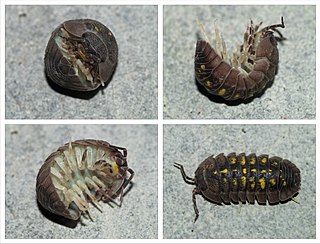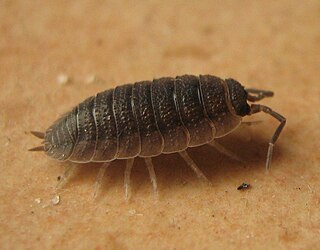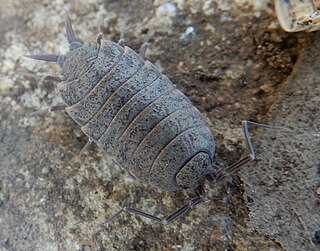
Armadillidium is a genus of the small terrestrial crustacean known as the woodlouse. Armadillidium are also commonly known as pill woodlice, leg pebbles, pill bugs, roly-poly, or potato bugs, and are often confused with pill millipedes such as Glomeris marginata. They are characterised by their ability to roll into a ball ("volvation") when disturbed.

Porcellionidae is a terrestrial family of the order Isopoda.

Haplophthalmus is a genus of woodlice in family Trichoniscidae. It contains 47 described species, of which two are listed as vulnerable species on the IUCN Red List – Haplophthalmus abbreviatus and Haplophthalmus rhinoceros.

Styloniscus is a genus of woodlice in the family Styloniscidae. It contains the following species as of 2010:
Soteriscus is a genus of woodlice in the family Porcellionidae found in Macaronesian islands and adjacent parts of Europe and Africa. It contains the following species:

Trichoniscidae are a family of isopods (woodlice), including the most abundant British woodlouse, Trichoniscus pusillus. Most species of woodlice that have returned to an aquatic or amphibian way of life belong to this family. Several species from the following genera live in water and on land: Titanethes, Cyphonetes, Alpioniscus, Scotoniscus, Bureschia, Brackenridgia, Mexiconiscus, Trichoniscoides, Cretoniscellus, Balearonethes and Cyphoniscellus.

Trichoniscus is a genus of woodlice. It contains over 100 species, including the common pygmy woodlouse, Trichoniscus pusillus:

Porcellionides is a genus of woodlice in the family Porcellionidae. It includes the following species :

Ligidium is a genus of woodlice. It contains about 46 species, six of which are probably taxonomic synonyms of Ligidium hypnorum or Ligidium germanicum. Of the remainder, eight species are found in North America, six in Japan, two in Taiwan, four in China, 12 in Turkey, the Caucasus, and Central Asia, and six in Greece.

Hemilepistus is a genus of woodlice, created by G. H. A. Budde-Lund in 1879 as a subgenus of Porcellio, but raised to the rank of genus by Karl Wilhelm Verhoeff in 1930. It contains the following species:

Trachelipus is a genus of woodlice in the family Trachelipodidae, containing the following species:

Armadillidae is a family of woodlice, comprising around 80 genera and 700 species. It is the largest family of Oniscidea, and one of the most species-rich families of the entire Isopoda. Armadillids generally have a strongly convex body shape, with some rather shallowly convex. Like members of the woodlice family Armadillidiidae, armadillids are capable of enrolling into a sphere (conglobation), and are commonly known as pill bugs. Armadillids differ from the Armadillidiidae in that the antennae are fully enclosed within the sphere.
Scleropactidae is a family of woodlice, with a predominantly Gondwanan distribution. It contains the following genera:

Tylos is a genus of woodlice in the family Tylidae. There are at least 20 described species in Tylos. All the species in this family can roll up into a perfect ball and live on sandy beaches.

Platyarthrus is a genus of woodlice in the family Platyarthridae. There are more than 30 described species in Platyarthrus.

Cylisticus is a genus of woodlice in the family Cylisticidae. There are at least 70 described species in Cylisticus.

Philoscia is a genus of woodlice in the family Philosciidae. There are more than 80 described species in Philoscia.

Eubelidae is a family of isopods belonging to the order Isopoda. It contains the following genera:















